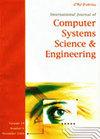求助PDF
{"title":"Quantum Inspired Differential Evolution with Explainable Artificial Intelligence-Based COVID-19 Detection","authors":"Abdullah M. Basahel, Mohammad Yamin","doi":"10.32604/csse.2023.034449","DOIUrl":null,"url":null,"abstract":"Recent advancements in the Internet of Things (Io), 5G networks, and cloud computing (CC) have led to the development of Human-centric IoT (HIoT) applications that transform human physical monitoring based on machine monitoring. The HIoT systems find use in several applications such as smart cities, healthcare, transportation, etc. Besides, the HIoT system and explainable artificial intelligence (XAI) tools can be deployed in the healthcare sector for effective decision-making. The COVID-19 pandemic has become a global health issue that necessitates automated and effective diagnostic tools to detect the disease at the initial stage. This article presents a new quantum-inspired differential evolution with explainable artificial intelligence based COVID-19 Detection and Classification (QIDEXAI-CDC) model for HIoT systems. The QIDEXAI-CDC model aims to identify the occurrence of COVID-19 using the XAI tools on HIoT systems. The QIDEXAI-CDC model primarily uses bilateral filtering (BF) as a preprocessing tool to eradicate the noise. In addition, RetinaNet is applied for the generation of useful feature vectors from radiological images. For COVID-19 detection and classification, quantum-inspired differential evolution (QIDE) with kernel extreme learning machine (KELM) model is utilized. The utilization of the QIDE algorithm helps to appropriately choose the weight and bias values of the KELM model. In order to report the enhanced COVID-19 detection outcomes of the QIDEXAI-CDC model, a wide range of simulations was carried out. Extensive comparative studies reported the supremacy of the QIDEXAI-CDC model over the recent approaches. © 2023 Authors. All rights reserved.","PeriodicalId":50634,"journal":{"name":"Computer Systems Science and Engineering","volume":"33 1","pages":"209-224"},"PeriodicalIF":2.2000,"publicationDate":"2023-01-01","publicationTypes":"Journal Article","fieldsOfStudy":null,"isOpenAccess":false,"openAccessPdf":"","citationCount":"0","resultStr":null,"platform":"Semanticscholar","paperid":null,"PeriodicalName":"Computer Systems Science and Engineering","FirstCategoryId":"94","ListUrlMain":"https://doi.org/10.32604/csse.2023.034449","RegionNum":4,"RegionCategory":"计算机科学","ArticlePicture":[],"TitleCN":null,"AbstractTextCN":null,"PMCID":null,"EPubDate":"","PubModel":"","JCR":"Q2","JCRName":"Computer Science","Score":null,"Total":0}
引用次数: 0
引用
批量引用
基于可解释人工智能的COVID-19检测的量子启发差分进化
物联网(Io)、5G网络和云计算(CC)的最新进展导致了以人为中心的物联网(HIoT)应用的发展,这些应用将基于机器监控的人类物理监控转变为机器监控。HIoT系统在智能城市、医疗保健、交通等多个应用中都有应用。此外,HIoT系统和可解释的人工智能(XAI)工具可以部署在医疗保健部门,以进行有效的决策。COVID-19大流行已经成为一个全球性的健康问题,需要自动化和有效的诊断工具来在初始阶段检测疾病。本文提出了一种新的基于量子启发的差分进化和可解释的人工智能的HIoT系统COVID-19检测与分类(QIDEXAI-CDC)模型。QIDEXAI-CDC模型旨在利用XAI工具在HIoT系统上识别COVID-19的发生。QIDEXAI-CDC模型主要使用双边滤波(BF)作为预处理工具来消除噪声。此外,将retanet应用于从放射图像中生成有用的特征向量。对于COVID-19的检测和分类,采用量子启发差分进化(QIDE)和核极限学习机(KELM)模型。QIDE算法的应用有助于合理选择KELM模型的权值和偏置值。为了报告QIDEXAI-CDC模型增强的COVID-19检测结果,进行了大范围的模拟。广泛的比较研究报道了QIDEXAI-CDC模型优于最近的方法。©2023作者。版权所有。
本文章由计算机程序翻译,如有差异,请以英文原文为准。


